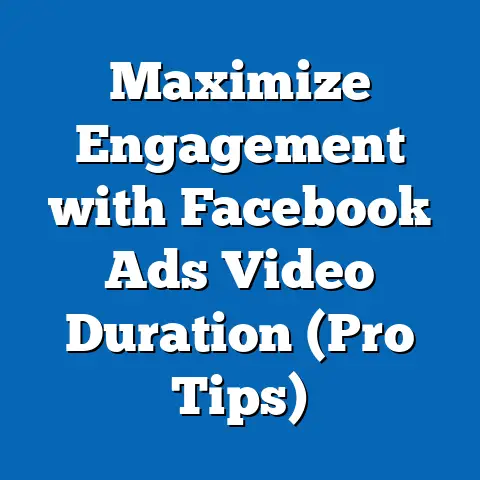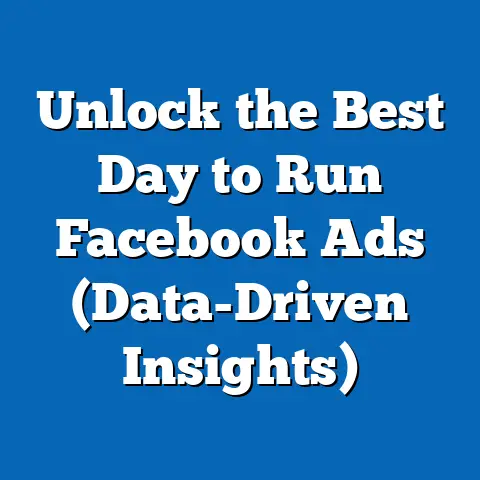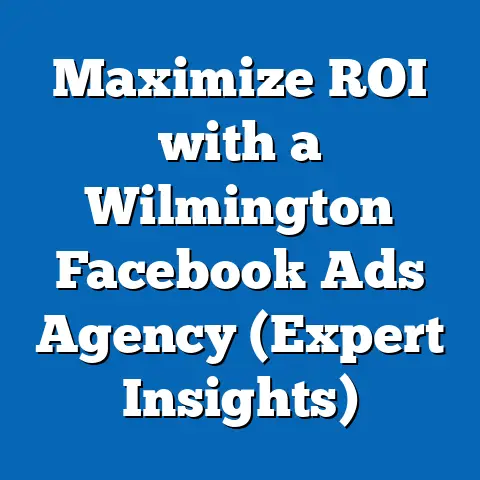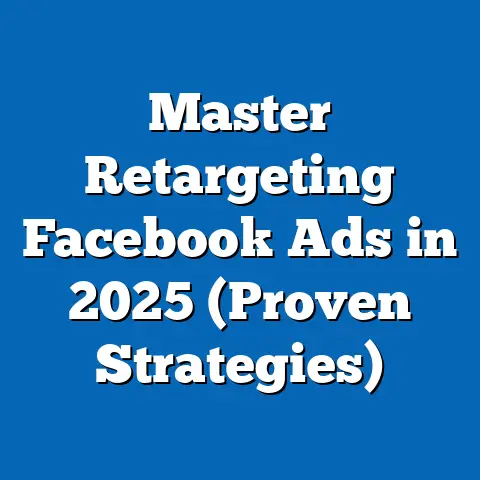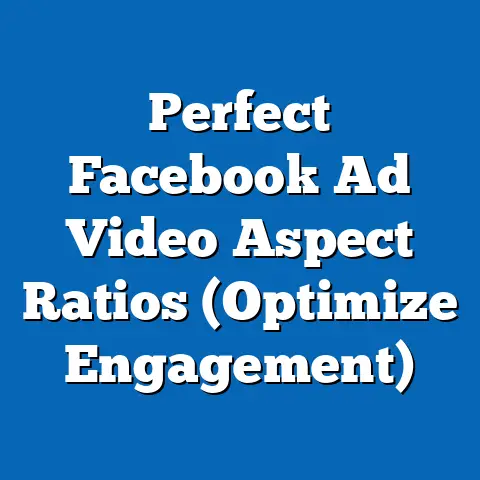Maximize Impact with Contextual Facebook Ads (Pro Strategies)
In today’s digital age, where consumers are bombarded with countless advertisements every day, it’s no longer enough to simply have a visually appealing ad. To truly capture attention and drive engagement, your Facebook ads need to be contextually relevant. That means understanding your audience, tailoring your message to their interests and needs, and delivering it in a way that feels authentic and natural.
I’ve spent years crafting and analyzing Facebook ad campaigns, and I can tell you firsthand that contextual advertising is a game-changer. It’s about moving beyond broad demographics and diving deep into the nuances of your target audience’s behavior, preferences, and motivations. When you nail the context, your ads become less of an interruption and more of a valuable addition to the user experience.
In this guide, I’ll share my pro strategies for maximizing impact with contextual Facebook ads. We’ll explore everything from understanding the fundamentals of contextual advertising to leveraging Facebook’s powerful ad features, crafting compelling visuals and messaging, and measuring your success. Get ready to transform your Facebook ad campaigns and achieve unprecedented results!
Understanding Contextual Advertising
Contextual advertising is a powerful approach to digital marketing that focuses on delivering ads that are relevant to the user’s current situation, interests, and online behavior. Unlike traditional advertising, which often relies on broad demographics or generic messaging, contextual ads are tailored to fit seamlessly within the user’s experience, making them more engaging and less intrusive.
What is Contextual Advertising?
Contextual advertising is all about relevance. It’s about showing the right ad to the right person at the right time, based on the context of their online activity. This context can include the content they’re viewing, the keywords they’re searching for, their location, and their past interactions with your brand or similar products.
For example, if someone is reading an article about hiking boots on a blog, a contextual ad might display a banner for a local outdoor gear store or a special offer on hiking socks. The ad is directly related to the user’s current interest, making it more likely to grab their attention and drive a click.
Contextual vs. Traditional Advertising: A Key Difference
The key difference between contextual and traditional advertising lies in the level of personalization and relevance. Traditional advertising often relies on broad demographics and generic messaging, while contextual advertising is highly targeted and tailored to the individual user.
Think of it this way: traditional advertising is like shouting a message from a rooftop, hoping someone in the crowd will hear it and be interested. Contextual advertising, on the other hand, is like having a one-on-one conversation with someone about a topic they’re already passionate about.
Contextual advertising enhances user engagement because it provides value. Instead of interrupting their experience with irrelevant ads, it offers them information or products that are genuinely useful and interesting. This leads to higher click-through rates, improved conversion rates, and a more positive brand perception.
Examples of Successful Contextual Advertising on Facebook
Facebook provides a fertile ground for contextual advertising, thanks to its rich user data and sophisticated targeting options. Here are a few examples of how brands have successfully leveraged contextual advertising on the platform:
- E-commerce Retargeting: Imagine you were browsing for a specific pair of shoes on an e-commerce website, but you didn’t make a purchase. With retargeting, that same e-commerce site can show you ads for those exact shoes on Facebook. This is contextual because it’s directly related to your recent browsing behavior.
- Interest-Based Targeting: If you’ve liked pages or joined groups related to cooking, you might see ads for kitchen gadgets, cooking classes, or meal delivery services. These ads are contextual because they align with your declared interests on Facebook.
- Location-Based Offers: If you’re traveling in a new city, you might see ads for local restaurants, attractions, or events. These ads are contextual because they’re relevant to your current location.
- Dynamic Product Ads: For businesses with large product catalogs, dynamic product ads can automatically show users ads for products they’ve viewed on your website or app. This is highly contextual and personalized, leading to improved conversion rates.
Takeaway: Contextual advertising is all about delivering relevant ads to the right people at the right time. By understanding your audience and leveraging Facebook’s targeting options, you can create ads that are more engaging, more effective, and less intrusive.
The Role of Audience Segmentation in Contextual Ads
Audience segmentation is the cornerstone of effective contextual advertising. It involves dividing your target audience into smaller, more homogenous groups based on shared characteristics, interests, and behaviors. This allows you to create highly targeted ads that resonate with each segment, leading to improved engagement and conversion rates.
Why Audience Segmentation Matters
Imagine trying to sell a high-end luxury car to everyone on Facebook. You’d be wasting a lot of money showing ads to people who can’t afford it or aren’t interested in luxury vehicles. That’s where audience segmentation comes in.
By segmenting your audience, you can focus your advertising efforts on the people who are most likely to be interested in your product or service. This not only saves you money but also increases the effectiveness of your ads by delivering a more relevant and personalized message.
Segmentation Strategies: Demographic, Psychographic, and Behavioral
There are several different ways to segment your audience, each with its own strengths and weaknesses. Here are three of the most common segmentation strategies:
- Demographic Segmentation: This involves dividing your audience based on basic demographic characteristics such as age, gender, location, education level, income, and occupation. This is a good starting point for understanding your audience, but it’s often not enough to create truly contextual ads.
- Psychographic Segmentation: This goes deeper than demographics by focusing on your audience’s values, attitudes, interests, and lifestyle. This allows you to understand their motivations and create ads that appeal to their emotional needs.
- Behavioral Segmentation: This involves dividing your audience based on their online behavior, such as their browsing history, purchase history, website interactions, and social media activity. This is the most powerful form of segmentation for contextual advertising because it allows you to target people based on their actual actions and interests.
Using Facebook’s Audience Insights Tools
Facebook provides a suite of powerful tools for gathering data and refining your targeting strategies. One of the most useful is Facebook Audience Insights, which allows you to explore the demographics, interests, and behaviors of your target audience.
With Audience Insights, you can:
- Discover the top interests of your audience, including the pages they like, the topics they discuss, and the brands they follow.
- Identify the demographics of your audience, including their age, gender, location, education level, and relationship status.
- Analyze the behavior of your audience, including their purchase activity, device usage, and online habits.
- Create custom audiences based on specific criteria, such as people who have visited your website, engaged with your Facebook page, or uploaded their contact information.
By leveraging Facebook’s audience insights tools, you can gain a deep understanding of your target audience and create highly targeted ads that resonate with their interests and needs.
Case Studies: Successful Audience Segmentation on Facebook
Let’s look at a couple of real-world examples of brands that have successfully used audience segmentation to improve the performance of their Facebook ads:
- A Fitness App: A fitness app segmented its audience based on fitness goals (weight loss, muscle gain, general fitness). They then created separate ad campaigns for each segment, featuring tailored messaging and visuals that resonated with each group’s specific motivations. This resulted in a significant increase in app downloads and user engagement.
- An Online Fashion Retailer: An online fashion retailer segmented its audience based on style preferences (bohemian, classic, trendy). They then used dynamic product ads to show each segment products that matched their style preferences. This led to a significant increase in click-through rates and conversion rates.
Takeaway: Audience segmentation is essential for creating effective contextual Facebook ads. By dividing your audience into smaller, more homogenous groups, you can create highly targeted ads that resonate with each segment, leading to improved engagement and conversion rates.
Crafting Compelling Visuals and Messaging
Once you’ve identified your target audience and segmented them based on their interests and behaviors, the next step is to craft compelling visuals and messaging that will capture their attention and drive engagement. This involves understanding the elements of design and copywriting that contribute to the success of contextual Facebook ads.
The Significance of High-Quality Visuals
In the world of Facebook advertising, visuals are king. Your ad’s image or video is the first thing people will see, so it needs to be eye-catching, relevant, and representative of your brand. High-quality visuals can communicate your brand’s message effectively within the right context.
Here are a few tips for creating compelling visuals for your Facebook ads:
- Use high-resolution images and videos: Avoid blurry or pixelated images, as they can make your brand look unprofessional.
- Choose visuals that are relevant to your target audience: Use images and videos that feature people, places, or things that your audience will find relatable and interesting.
- Use visuals that are consistent with your brand identity: Use colors, fonts, and styles that are consistent with your brand’s overall look and feel.
- Test different visuals to see what works best: Experiment with different images and videos to see which ones generate the most engagement.
The Importance of Storytelling in Ad Copy
While visuals are important, they’re not the only factor that contributes to the success of contextual Facebook ads. Your ad copy also plays a crucial role in capturing attention and driving engagement.
Storytelling is a powerful technique for creating ad copy that resonates with your audience on an emotional level. By telling a story, you can create a connection with your audience and make your brand more relatable.
Here are a few tips for using storytelling in your ad copy:
- Focus on the benefits, not the features: Instead of simply listing the features of your product or service, focus on the benefits it provides to your audience.
- Use vivid language and imagery: Paint a picture in your audience’s mind by using descriptive language and evocative imagery.
- Create a sense of urgency: Encourage your audience to take action by creating a sense of urgency or scarcity.
- Use a call to action: Tell your audience exactly what you want them to do, whether it’s to visit your website, download your app, or make a purchase.
Aligning Visuals and Messaging with Your Audience and Brand
The key to creating compelling visuals and messaging is to align them with your target audience’s preferences and your overall brand identity. This means understanding what your audience cares about, what motivates them, and what kind of language and imagery they respond to.
Here are a few tips for aligning your visuals and messaging with your audience and brand:
- Research your target audience: Use Facebook Audience Insights to learn more about your audience’s demographics, interests, and behaviors.
- Develop a brand voice and style guide: This will help you ensure that all of your visuals and messaging are consistent with your brand identity.
- Test different visuals and messaging to see what works best: Experiment with different approaches to see which ones generate the most engagement.
- Get feedback from your target audience: Ask your target audience for feedback on your visuals and messaging to see if they resonate with them.
Takeaway: Crafting compelling visuals and messaging is essential for creating effective contextual Facebook ads. By using high-quality visuals, telling engaging stories, and aligning your visuals and messaging with your audience and brand, you can capture attention, drive engagement, and achieve your marketing goals.
Leveraging Facebook’s Ad Features for Contextual Relevance
Facebook offers a plethora of ad formats and features designed to enhance contextual advertising. Understanding and utilizing these tools effectively is crucial for reaching the right people with the right message at the right time.
Ad Formats: Carousel, Video, and Dynamic Ads
Facebook provides a variety of ad formats, each with its own strengths and weaknesses. Here are three of the most popular ad formats for contextual advertising:
- Carousel Ads: Carousel ads allow you to showcase multiple images or videos within a single ad unit. This is a great way to highlight different products, features, or benefits. For example, a clothing retailer could use a carousel ad to showcase different outfits or styles.
- Video Ads: Video ads are highly engaging and can be used to tell stories, demonstrate products, or share testimonials. Video ads are particularly effective for capturing attention and driving engagement. For example, a travel company could use a video ad to showcase a beautiful destination.
- Dynamic Ads: Dynamic ads automatically show users ads for products they’ve viewed on your website or app. This is highly contextual and personalized, leading to improved conversion rates. For example, an e-commerce store could use dynamic ads to retarget users who have abandoned their shopping carts.
Targeting Options: Custom and Lookalike Audiences
Facebook’s targeting options are incredibly powerful and allow you to reach specific groups of people based on their demographics, interests, behaviors, and connections. Here are two of the most useful targeting options for contextual advertising:
- Custom Audiences: Custom audiences allow you to target people who have already interacted with your business, such as people who have visited your website, engaged with your Facebook page, or uploaded their contact information. This is a great way to retarget potential customers and drive conversions.
- Lookalike Audiences: Lookalike audiences allow you to target people who are similar to your existing customers. This is a great way to expand your reach and find new customers who are likely to be interested in your product or service.
The Power of Facebook Pixel
The Facebook Pixel is a small piece of code that you can install on your website to track user behavior. This allows you to gather valuable data about your audience and optimize your ad campaigns based on contextual data.
With Facebook Pixel, you can:
- Track conversions: See which ads are driving the most conversions on your website.
- Retarget website visitors: Show ads to people who have visited your website but haven’t made a purchase.
- Create custom audiences: Create custom audiences based on specific actions that people have taken on your website.
- Optimize ad campaigns: Optimize your ad campaigns based on the data you’ve collected from Facebook Pixel.
Takeaway: Leveraging Facebook’s ad features is crucial for creating effective contextual Facebook ads. By utilizing the right ad formats, targeting options, and the Facebook Pixel, you can reach the right people with the right message at the right time.
Measuring Success: Metrics and Analytics
Measuring the success of your contextual Facebook ads is essential for understanding what’s working and what’s not. By tracking key performance indicators (KPIs) and analyzing campaign data, you can refine your ad strategies and maximize your impact.
Key Performance Indicators (KPIs)
Here are some of the most important KPIs to track when measuring the success of your contextual Facebook ads:
- Click-Through Rate (CTR): This measures the percentage of people who clicked on your ad after seeing it. A high CTR indicates that your ad is relevant and engaging.
- Conversion Rate: This measures the percentage of people who took a desired action (e.g., made a purchase, downloaded an app, signed up for a newsletter) after clicking on your ad. A high conversion rate indicates that your ad is effective at driving results.
- Cost Per Click (CPC): This measures the average cost you pay each time someone clicks on your ad. A low CPC indicates that your ad is efficient at driving traffic.
- Cost Per Acquisition (CPA): This measures the average cost you pay each time someone takes a desired action after clicking on your ad. A low CPA indicates that your ad is efficient at driving results.
- Return on Ad Spend (ROAS): This measures the amount of revenue you generate for every dollar you spend on advertising. A high ROAS indicates that your ad is profitable.
The Importance of A/B Testing
A/B testing is a powerful technique for refining your ad strategies and maximizing your impact. It involves creating two or more versions of your ad and testing them against each other to see which one performs better.
By A/B testing different elements of your ad, such as the visuals, the ad copy, the targeting options, and the call to action, you can identify the most effective combinations and optimize your campaigns for maximum results.
Analyzing Campaign Data
Analyzing your campaign data is essential for gaining insights into audience behavior and preferences. By understanding how your audience is responding to your ads, you can refine your targeting strategies, improve your ad copy, and optimize your campaigns for better results.
Facebook provides a variety of tools for analyzing your campaign data, including Facebook Ads Manager and Facebook Analytics. These tools allow you to track your KPIs, identify trends, and gain insights into your audience’s behavior.
Takeaway: Measuring the success of your contextual Facebook ads is essential for understanding what’s working and what’s not. By tracking key performance indicators, A/B testing different elements of your ad, and analyzing campaign data, you can refine your ad strategies and maximize your impact.
Conclusion
In conclusion, maximizing impact with contextual Facebook ads is about understanding your audience, tailoring your message to their interests and needs, and delivering it in a way that feels authentic and natural. By leveraging the strategies outlined in this guide, you can transform your Facebook ad campaigns and achieve unprecedented results.
Remember, contextual advertising is not a one-size-fits-all approach. It requires ongoing experimentation, analysis, and optimization to find what works best for your business and your target audience. But with the right strategies and the right tools, you can create Facebook ads that are not only effective but also engaging, relevant, and valuable to your customers. So go ahead, implement these strategies, and watch your Facebook ad campaigns soar!

